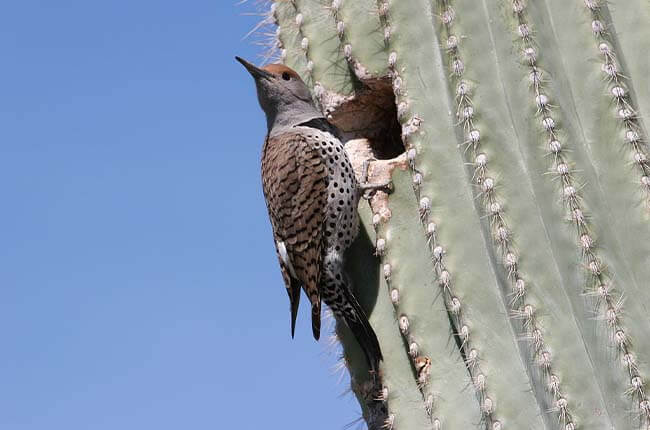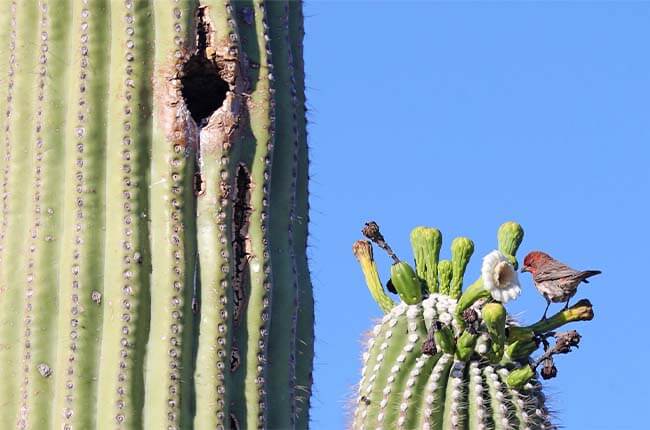Cacti, as hardy as they are, can sometimes develop holes due to various factors. What causes holes in a cactus?
The holes in cacti are primarily due to tissue damage caused by certain bird species, insect infestation, rodents, bacterial and fungal diseases, physical damage, overwatering and poor drainage, freeze and sun damage.
In this article, we will look at these causes and what you can do to prevent and fix the holes in cacti.
Why are there holes in cacti?
Here are some reasons your cactus might be developing holes:
Insect infestation
Insects such as cactus moths, scale insects, mealybugs, termites, and cactus beetles are common pests that burrow into cacti.
They do so to feed on the plant’s tissue, seek shelter within it, or to lay eggs, causing small to large holes and even tunnels.
These pests often leave visible signs of their presence, such as a waxy residue or small brown or black spots around the hole.
Bird damage
Certain species of birds, like the woodpeckers and gilded flickers, are known to create holes as nests in cacti, protecting their eggs and young from predators and extreme temperatures.
No other birds actively drill holes, although cactus wrens and doves might construct nests in the crotches of the cactus.
The birds drill holes mostly in the columnar type of cacti. Interestingly, the orientation of the holes they drill may be influenced by the sun’s position and the direction of the wind. In a study of the holes in cardon cacti in Mexico, the gilded flickers are found to make cavity entrances toward the north-northwest side of the cactus, facing away from the other cactus arms (Zwartjes & Nordell 1998).

Rodent damage
If your cactus is outdoors, it might be subject to damage from small mammals. Rodents like mice, rats, and squirrels may gnaw at cacti for hydration and nutrients, creating holes in the process.
Bacterial or fungal diseases
Pathogens like bacteria and fungi can cause rot, scabs, or lesions in cacti, resulting in the formation of hollow sections or holes.
For example, Fusarium oxysporum is a well-known fungus that can cause wilt and rot in many types of plants, including cacti. In severe infections, these fungi can cause tissue death, which might appear as holes.
Similarly, Phytophthora cactorum is a water mold that causes cactus rot, which can lead to symptoms like holes in the plant.
Bacterial pathogens can also lead to similar symptoms. Erwinia carotovora, for instance, is known to cause soft rot in many types of plants.
Both fungal and bacterial infections usually enter the plant through wounds or natural openings. Once inside, they produce enzymes and toxins that degrade the plant’s cell wall, leading to tissue decay and the appearance of rot or holes.
A fungal or bacterial infection first appears as dark spots on stems and feels mushy to touch. When it advances, the plant tissues would die off and dry out leaving a black spot or a hole.
Physical damage
If a cactus is bumped, scraped, or punctured, it may develop a wound that appears as a hole. These wounds can also provide an entry point for bacteria or fungi, leading to disease.
Environmental factors such as heavy rains or strong winds can also result in breakage, creating openings in the plant.
Overwatering and poor drainage
Overwatering and poor drainage do not directly cause holes in cacti, but they create conditions that are more conducive to the growth and spread of pathogens that can cause rot, which may manifest as holes or lesions.
Cacti are native to arid regions and are adapted to survive in conditions of water scarcity. They have evolved to store water within their thick, fleshy tissues. This makes them highly susceptible to issues like root rot and fungal infections when they are exposed to excessive water or poor drainage.
Here is how it works:
Overwatering: When a cactus is overwatered, the excess moisture can cause the roots to become waterlogged and oxygen-starved. This can lead to the death of root tissues, a condition commonly known as root rot.
Dead roots are more susceptible to secondary infections by pathogens, such as certain bacteria and fungi, which can then spread to the stem and cause tissue death, appearing as holes or rot.
Poor Drainage: If the pot or ground where the cactus is planted doesn’t drain well, water can accumulate around the roots. This stagnant water can become a breeding ground for harmful fungi and bacteria.
Like overwatering, this can lead to root rot and subsequent infection.
Freeze damage
Cacti are not well-suited to freezing temperatures.
The water inside the cactus can freeze, causing cell walls to rupture.
When the cactus thaws, this can result in mushy spots that eventually turn into holes.
Sunburn
While cacti are adapted to handle a lot of sunlight, they can still get sunburned, especially young cacti or those that have been moved from a lower light environment to direct sun.
Sunburn often presents as white or yellowish discoloration, and in severe cases, the burned tissue can die and fall away, leaving a hole.
How to prevent holes in cactus?
After knowing why holes occur in your cactus, it would be much easier to find treatment options to help it thrive.
- Select proper pot size
Choosing the right pot size for your cactus is vital, especially when considering the depth of the pot and the root structure of your specific cactus species.
Cacti generally have a relatively shallow and fibrous root system that spread out wide rather than deep. This root structure adapts to desert environments, where water is scarce and often only present at the surface after a short rain.
- Provide drainage
Cacti are native to regions with arid climates and are adapted to survive in dry conditions. It’s crucial to provide proper drainage and avoid overwatering your cacti to maintain healthy root systems.
One way to achieve this is by incorporating well-draining materials, such as perlite, into your soil mix.
- Improve watering schedule
Most cactus species don’t prefer humidity, and overwatering can contribute to root problems.
To manage your watering schedule, observe your cacti closely, and tailor your watering frequency to their needs. Keep in mind factors such as seasonal variations, humidity, and the size and type of your cactus when determining how often to water your plants.
Remember, it’s better to err on the side of under-watering than over-watering. By taking these precautions, you’ll help ensure the long-term health and vitality of your cacti.
- Pest control
Pest control is essential to maintaining healthy cacti and preventing damage caused by these common pests. Pesticides may be necessary to keep these pests in check. Still, it is crucial to choose appropriate chemicals that will not harm beneficial organisms like cactus bees which are essential for cactus pollination.
Early detection of pests and removal of infected plants can also help prevent the spread of infestations.
In addition to chemical and biological methods, some physical barriers like wire mesh or fencing can be used to deter larger pests such as rodents. These barriers protect cacti from damage while minimizing the chance of injury to pests.
Proper cactus care like watering, fertilization, and pruning can also contribute to pest management by promoting healthy plant growth and making the cactus less susceptible to pest attacks.
What to do with the holes in cacti?
- Removing pests
To treat a cactus infested with pests, use an insecticide specifically designed for the targeted pests. In some cases, manually removing pests with a pair of tweezers may also work.
- Preventing rot
If the hole in your cactus was previously a soft spot caused by moisture and rot, carefully examine the cactus for signs of overwatering or moisture retention, such as discolored or soft areas.
A sharp knife can be used to gently remove the rotted sections, allowing the healthy parts of the plant to thrive. Always sterilize the knife before and after cutting to prevent the spread of infection.
- Repairing mechanical damage
If the damage is caused by accidents, such as dropping a pot or getting accidentally cut, the plant will heal on its own with time in most cases.
However, if the damage is extensive or affects the overall health of the cactus, you may consider removing the damaged parts to prevent infection.
Happy gardening!
Related
Do Cacti Like Humidity? (Species List Included)
Do All Cactus Grow Arms: 3 Factors (Explained)
Source
Zwartjes, P. W. & Nordell, S. E. (1998). Patterns of Cavity-Entrance Orientation by Gilded Flickers (Colaptes Chrysoides) in Cardón Cactus, The Auk, Vol. 115 (1), pp. 119–126, https://doi.org/10.2307/4089117
- Keiki Paste vs Rooting Hormone:What’s the difference? - February 4, 2024
- Top 10 Orchid Fertilizers: A Comprehensive Review (2024) - February 2, 2024
- Top 8 Soil Inoculants For Stronger Plants (2024) - February 1, 2024


